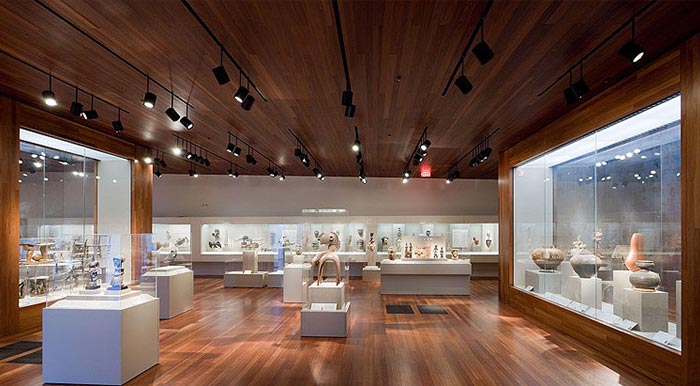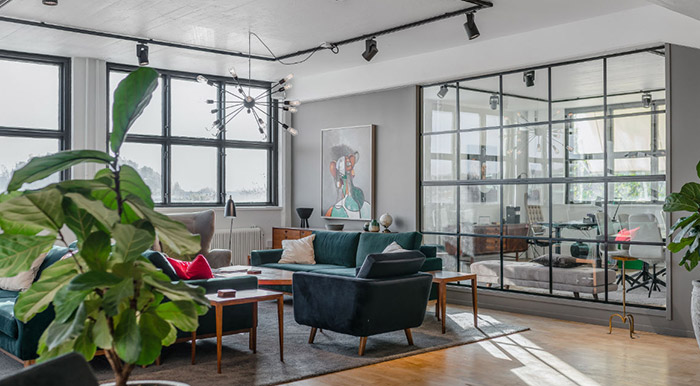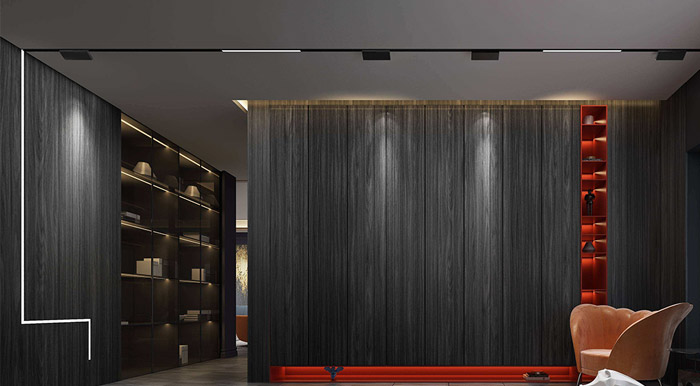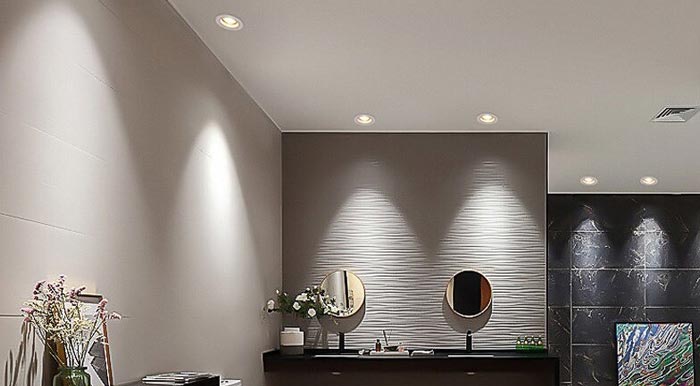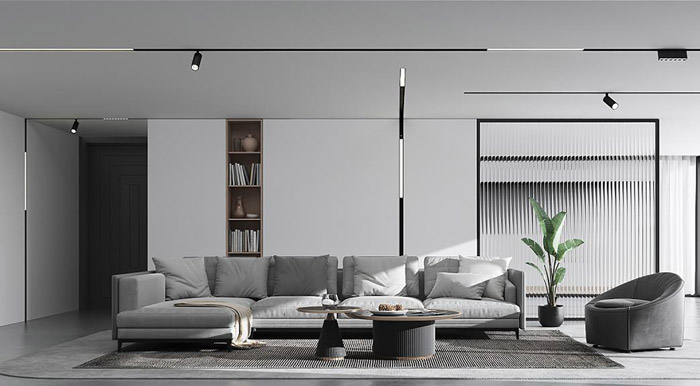Understanding Track Lighting
In the vast world of lighting, there are a lot of shiny, sparkling pieces that exist only to light up a room. Some are intended to offer soft light, others bright light, and some are just there to add a little color. It's easy to get lost in the crowd, sorting through every type and design to find the one that suits your home best. The lighting should be bright enough to do the job, but also something that works with the design of the room, and those defining characteristics are not always clear when shopping online.
With led track lighting in particular, not only are there a lot of options, there’s a fair amount of confusing information. An online search returns conflicting definitions of terms because track-based lighting systems are so unique that they even use common parts differently from the rest. It can be frustrating to find the answers to the simple questions. It doesn’t need to be. Before you buy a track lighting system, look at the basics that follow and decide for yourself if track lighting is the answer to your home lighting system setup.
What Is Track Lighting?
Track lighting is - as the name implies - any lighting feature that uses a ceiling mounted support track or a rail to provide the electricity to individual light fixtures. With any other lamp, (or luminary,) a light bulb twisted into a lamp socket creates the electric connection with the lamp in order to light up the bulb inside. Track lighting works much the same way, except the whole light fixture itself connects to the track to draw energy, rather than just the bulb.
This allows flexibility in placement as the lights can be attached to the track anywhere they are needed, rather than at a particular fixture like a light bulb socket requires. Standard incandescent, low-voltage Halogen/Krypton, CFL, and energy-efficient LED track systems are all available, just like any other lighting solution. The luminary can be angled to cast light in all directions along the track, or can be moved to another spot along the track, and there’s no new wiring required or no new electrical plugs to be found. The track or rail is electrified at one end and can be extended or curved to reach out from the source.
Designed to be fully customizable, the different track systems sit close to the ceiling and out of the line of sight, while providing more directional light than a ceiling lamp can offer. They provide bright, clear illumination or soft dimmable lighting to accent the design of the room itself. The individual lighting fixtures can be fit with a variety of shapes and sizes to help them blend in, whether the look is traditional or contemporary.
While they are all considered a form of track lighting, monorail lighting and cable lighting are not the same as standard track lighting. They are each different lighting systems while offering similar characteristics, but they are in no way interchangeable. Track lighting, cable lighting, or rail lighting, are all very distinctive in their design and can fit easily into either your home or your business decor. They all allow you to design your own layout, creating a maze on the ceiling of straight lines, boxes, or curving and playful rails. They are useful in any space, from rooms with a high ceiling that require a brighter spread over a large area, to cramped hallways and closets, to kitchens. While track lighting blends in well to any modern design, cable lighting provides a very industrial, contemporary look, anchoring to walls as well as the ceiling to enable the light to reach otherwise difficult lighting spaces. The rails can be installed with gentle curves or full circular shapes to add interest, or they can follow the walls, even taking 90-degree turns to adjust to corners.
If you have any other questions, you can email us or contact us, We are a professional manufacturer of LED track lights.
Types of Track Lighting
The defining characteristic of track lighting is that the light mounts on a support track in order to power the fixture. Over the years, the look of the track has evolved into different designs to allow you to configure the luminary to suit your space. These different styles all fall under the general umbrella of track lighting, however, they are all very different forms of lighting systems.
Standard Linear Track Lighting
Standard linear track lighting is the “traditional” track lighting, easily installed with simple screws and connected to existing electrical circuits, usually in the ceiling. An enclosed and hollow, square-edged bar is mounted to the ceiling, and the light fixture is inserted between the tracks and twisted to catch the inside ledge of the bar to secure the luminary. Inside, exposed electrical conduit run the length of the track, secured in grooves, and the metal in the base of the luminary touches the connections, powering the individual light by the circuit at the end of the track.
The tracks usually come in straight bars, ranging from 2-foot to 8-foot lengths. They can be run in straight lines parallel to the walls, or they can be connected in specific layouts, like a corner angle, or multiple pieces can be connected to create an X-shape. The tracks are powered by either line voltage or low voltage wiring running from the circuit to the end of the bar, in 2- or 3-wire configurations. Connectors are used to attach separate track pieces together and allow the live current to continue from track to track.
Track heads are light fixtures that connect to the track and are usually 12 or 24 volts, so they consume less energy, which means a less expensive energy bill. These include a transformer, built into the track head base, to step down the current from your home’s 120 volt circuit. Since each individual light has the transformer already included, linear track lighting doesn’t require a separate transformer to power the entire system.
There are three standard types of tracks used in North America: H type, J type, and L type. The standards between the three types were developed by three different manufacturing companies, Halo, Juno, and Lightolier, which they are named for. There are additional types that can vary by manufacturer, such as the two-circuit J2 system, which is used to control two sets of lighting on a single track. The tracks are similar in features and options when it comes to performance, but they are not interchangeable. The individual light bases insert into the track and twist to lock in place, powering the lights through the connection to the conduit in the track, so the light and track pieces have to fit together smoothly.
You can also read our other article, How to Choose Led Track Lighting?
Monorail Lighting
The most obvious characteristic difference with monorail lighting is that it drops down from the ceiling. The rails are suspended from the ceiling by rods called standoffs. Unlike the square bar shape of standard tracks, monorails are flexible and narrow. The rail can be bent and curved as much as 30 degrees.
The monorail is powered by a current that runs through the exposed metal of the rail itself. Because of this, most rails will require a transformer to step-down the voltage going to the conduits. The conduits are metal plates fitted on either side of an insulating connector to conduct the low-voltage electricity along the rail. The luminary is then attached to and draws power directly from the rail.
Though there are some line voltage monorail systems that rely on the standard 120 volt circuit, most monorail tracks are limited by design. For low voltage monorails, the rail can only support a maximum wattage based on the transformer used for any individual system. Given that each individual luminary requires a specific number of watts to power it, the maximum watts allowed on a rail should be less than the total voltage it can provide, which limits the number of lamps that can be used on the track.
Cable Lighting
With cable lighting, there are no bars or boxes. The trackheads are instead suspended from the ceiling by sturdy cable and supported by turnbuckles, or stretching screws. They have a uniquely industrial look because of the exposed cables and mounting hardware, and blend well in buildings designed with exposed ductwork or vaulted ceilings.
The low-voltage conductive cables are very versatile across different styles of architecture, particularly where the design prevents electrical access at the ceiling level. They can be anchored by additional cables from a nearby wall or other fixtures. They can be suspended to hang from the ceiling, stretch from wall to wall, or variations in between.
Unlike track and monorail systems, cable lighting is limited to single circuit operation, so each track of lights will need their own lightswitch. They will also need transformers to step down to 12 or 24 volts from the standard home’s power. Surface transformers then deliver the power directly to the cables to power your choice of lighting fixtures, from pendants to spotlights and track heads. Different transformers provide different amounts of power, based on the number of lights and the amount of energy they consume. If you plan to install more than 300 watts on a 12 volt connection or more than 600 watts on a 24 volt connection, you will need a second transformer to share the demand.
Parts and Pieces
There’s more to these systems than just the track, of course. The additional required components for track lighting offer more customization to your lighting needs, so look for the accessories that best fit your system.
- Powerfeed - The powerfeed is the connection point between the electricity source and the track, rail, or cable.
- Connectors - Connectors serve to extend the track along the same powersource. They safely provide an uninterrupted power connection across multiple pieces of track, without requiring a new powerfeed, allowing you to design your own lighting layout.
- End Connectors - Electricity moves from negative to positive connections, in a cyclical circuit, so the end connectors are necessary to complete the circuit from the power source to the end of your track system.
- Suspension kits - Suspension kits are the means with which you mount rail or cable lighting to the ceiling. They consist of standoffs, turnbuckles, re-routers, or other supports.
- Fixtures - The fixtures are the different kinds of luminary or lamps that can be adapted to attach to the track. These are usually some form of trackhead or pendant light that are equipped with specific adapters to allow them to work with specific track systems.
- Trackhead - A trackhead is a smaller, bright, flexible light solution that can be aimed and directed like a spotlight.
- Pendant - Pendant lights are a decorative lighting fixture available to track lighting. As they hang suspended, they are less flexible than the trackheads and provide downlighting or ambient lighting.
Another entry often found under track lighting are fixed rail lighting fixtures. While they are installed on a track, they are different from a track lighting system in that fixed rail lighting is usually mounted to the wall, rather than the ceiling. They are often found in bathroom lighting, over vanities. A fixed rail track lighting kit has the benefit of installing into a ceiling fixture the same way as a ceiling light or fan would be installed, with no extra track necessary. These offer lights that are fixed to a certain point along the track, with only the light head moveable.
If you have any other questions, you can email us or contact us. We are the led track light factory.
Advantages of Track Lighting
Is track lighting better than a ceiling fan, recessed lighting, or any of the other lighting choices out there? That depends entirely on how you want to use the lighting in your room. There are certainly advantages with track lighting to be considered when you make your choice.
Because of the customization of the plug-and-play lighting setup, you can optimize the use of the luminary, illuminating exactly what and where you want at the flip of a switch.
- You can link tracks together or bend them around corners, aim some spotlights to the left, some to the right, and some straight down, wherever the light is most needed.
- Multiple trackheads can be tapped into the same circuit, saving you money on your electric bill.
- Two-circuit lighting systems are available that allow you to have independent control of two sets of lights installed on a single rail.
- Architectural grade and 277 volt commercial track lighting are available to customize larger lighting projects.
From a single electricity source, track, rail, and cable systems can provide multiple kinds of lighting.
- General lighting, or ambient light, brightens up the room or hallway through softer colors, a wider light spread, or different light shades.
- Directed task lighting can be focused on just a desk, table, or other working space to provide appropriate lighting for different detail work.
- Angling a light against a wall or object can offer accent lighting to highlight a specific feature of the architecture or room design.
Track lighting can adjust to your needs as your needs change. You aren’t locked into one set style, and no home renovations are needed if you want to change the look of the room.
- When you move a desk or a couch and need the light to follow it, just reposition the angle of the luminary.
- The lamps can be changed with your decor. From a simple track lighting head or spotlight, to chandeliers and pendants, glam it up or dress it down as the room requires.
- Tracks can be recessed, or set into the ceiling to hide the track.
Another advantage with track lighting is that you can choose to build it yourself with your favorite of the different track types and your preferred pendant, or you can buy track lighting kits already assembled.
If you need ODM service of led track lights, please contact us.
Disadvantages of Track Lighting
There are some instances where track lighting will not be the best choice. Rooms with lower ceilings are bad candidates for track lighting, as the tracks, rails, or cables will potentially hang down into the walking area of the room. The track contains an exposed line to the circuit and people could get shocked by coming into contact with a powered track. They have a sharp profile, and in narrow or low-ceiling areas, they could be a hazard for walking, or moving objects, such as the swing of a door or certain types of windows, or ceiling fans.
Another consideration is the style itself. These are built on a track, a rail, or a cable suspension system, and they have a distinct, modern look. They can work to create a contemporary style when combined with more traditional themed rooms, but they could clash in a formally decorated room. If a room is designed to match a certain time period where these technologies didn’t exist, they will stand out and distract from the intended look.
Manufacturers will typically make lighting options specific to their own systems, so there’s not a lot of room for mixing fixtures. It’s best to look around at what lighting designs - such as spotlights, pendants, or chandeliers - might work best in your rooms before determining which system or track you want. You will likely be limited to the system’s specific brand when it comes to replacing or updating lights later on. Some brands, such as WAC Lighting, will provide track and lighting options compatible with other brands, so look into compatibility before buying.
Voltage considerations
While track lighting is relatively simple to use and to install, some types do have different voltage options than your average lamp. Typically, they aren’t just plugged into the wall outlet. Like a ceiling fan, they have to be wired into the electric to sync up with the light switch on the wall. When looking at rail or cable lighting, pay attention to the voltage or wattage requirements of the lights. Most residential track lighting will likely be line voltage, but it’s important to be aware of the differences and verify what you’re working with when making a kit yourself.
Each light that you attach to a rail or track will use a certain number of watts. When the watts of all lamps on a track are added together, it must equal less than the total provided by the circuit. There’s a limited total number of watts available from a single circuit based on the voltage it provides, so you can only use the number of lights allowed by the fixtures’ wattage requirements.
The lighting systems for the different kinds of track lighting are available as line voltage systems or as low voltage systems. The power feed coming out of the wall in your home will likely provide the standard 110 to 120 volts and should work well with a line voltage system. These systems offer a variety of options, and are generally easier to maintain.
Low-voltage systems are different. They operate at 12 to 24 volts, significantly different than the power provided by your home. A transformer is used in these systems to convert, or step down, your home’s regular current to make them a lower, safer voltage for the lighting system. Low voltage systems allow you to dim the lights, and offer greater control in how you want to light the area, from color to distribution.
It’s important that you don’t mix and match voltage. If the lighting requires a 12 volt system, don’t supply it with a 24 volt circuit. Likewise, a 12 volt circuit will not adequately power a 24 volt lighting system. Adapters and transformers are available and sometimes necessary for your home.
When Purchasing Your System
It’s best to purchase all pieces for a track system from the same manufacturer. While it is possible to mix-and-match between different manufacturers, the different brand's pieces or fixtures may not be compatible. Connecting pieces from different manufacturers will void any warranties.
There are kits available that included everything needed to set up a basic track lighting system, but you can assemble your own from individual pieces. Assembling your own kit can provide more freedom in the fixtures and personalization for the layout. If buying a kit, the listings for the kits should clearly list out what components are included in the system package, and whether or not you need to purchase any additional parts.
